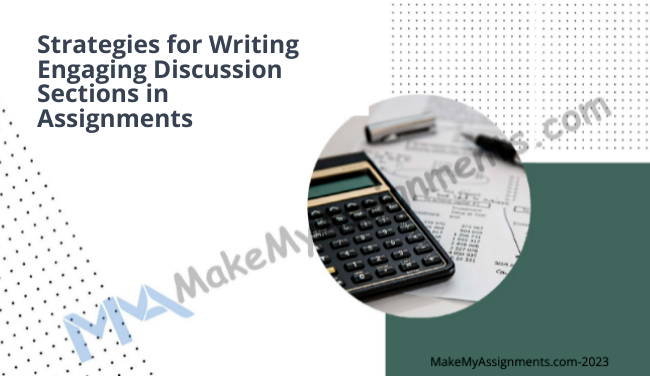
Strategies for Writing Engaging Discussion Sections in Assignments
Writing assignments often require students to not only present information but also engage in critical thinking, analysis, and interpretation. One crucial section that embodies these aspects is the discussion section. In this blog, we’ll explore effective strategies to craft engaging and thought-provoking discussion sections that will elevate the quality of your assignments.

1. Understand the Purpose: Before diving into writing, it’s essential to understand the purpose of the discussion section. This section is your opportunity to interpret and analyze the results or findings presented in the earlier sections of your assignment. It’s where you show your understanding of the topic and its broader implications.
2. Relate to Objectives: Ensure that your discussion aligns with the objectives of the assignment. Highlight how your analysis and conclusions contribute to the broader learning goals. This connection will provide a sense of purpose and relevance to your readers.
3. Structure for Clarity: A well-structured discussion is easier to follow and engages the reader effectively. Consider organizing your discussion section in a logical sequence:
- Summarize Key Findings: Start by succinctly summarizing the main findings or results of your analysis.
- Interpretation and Analysis: Dive into the interpretation of these findings. Explain their significance and consider different angles or perspectives. What patterns, trends, or anomalies did you observe?
- Compare with Literature: Discuss how your findings align or differ from existing literature. This demonstrates your awareness of the broader academic context.
- Address Limitations: Transparently address any limitations in your study. This showcases your critical thinking and awareness of the scope of your work.
- Propose Implications: Discuss the implications of your findings. How might they impact the field, practical applications, or future research?
4. Engage with Multiple Perspectives: To make your discussion more engaging, explore different viewpoints or theories related to your topic. Discuss how your findings align or challenge these perspectives. Engaging with diverse viewpoints shows depth in your analysis and encourages readers to think critically.
5. Pose Thoughtful Questions: Pose open-ended questions that stimulate further thinking. This invites readers to reflect on the topic and consider its broader implications. For instance, you could ask, “What are the potential ethical considerations of these findings?” or “How might this research contribute to solving real-world challenges?”
6. Use Clear Language: Engaging discussions are built on clear and concise language. Avoid jargon or overly technical terms without proper explanation. Aim to convey complex ideas in a straightforward manner, ensuring that readers from various backgrounds can understand your points.
7. Connect Back to Introduction: Create a sense of cohesion in your assignment by referring back to the introduction. Highlight how your findings and analysis relate to the initial research question or hypothesis. This narrative thread gives your assignment a unified feel.
8. Incorporate Visual Aids: If applicable, consider using graphs, charts, or diagrams to visually represent your findings. Visual aids can make complex information more accessible and engaging, reinforcing your points effectively.
9. Be Balanced: While it’s important to showcase the strengths of your findings, also acknowledge any limitations or uncertainties. Demonstrating objectivity and balance in your discussion lends credibility to your work.
10. Proofread and Edit: A discussion section that’s riddled with errors can undermine its impact. Proofread your work carefully, ensuring that your ideas are communicated clearly and effectively.
In conclusion, the discussion section of an assignment is your platform to showcase your analytical skills, critical thinking, and understanding of the subject matter. By following these strategies, you can create discussion sections that not only engage your readers but also contribute meaningfully to the academic conversation. Remember, an engaging discussion invites readers to reflect, question, and consider the broader implications of your work.





